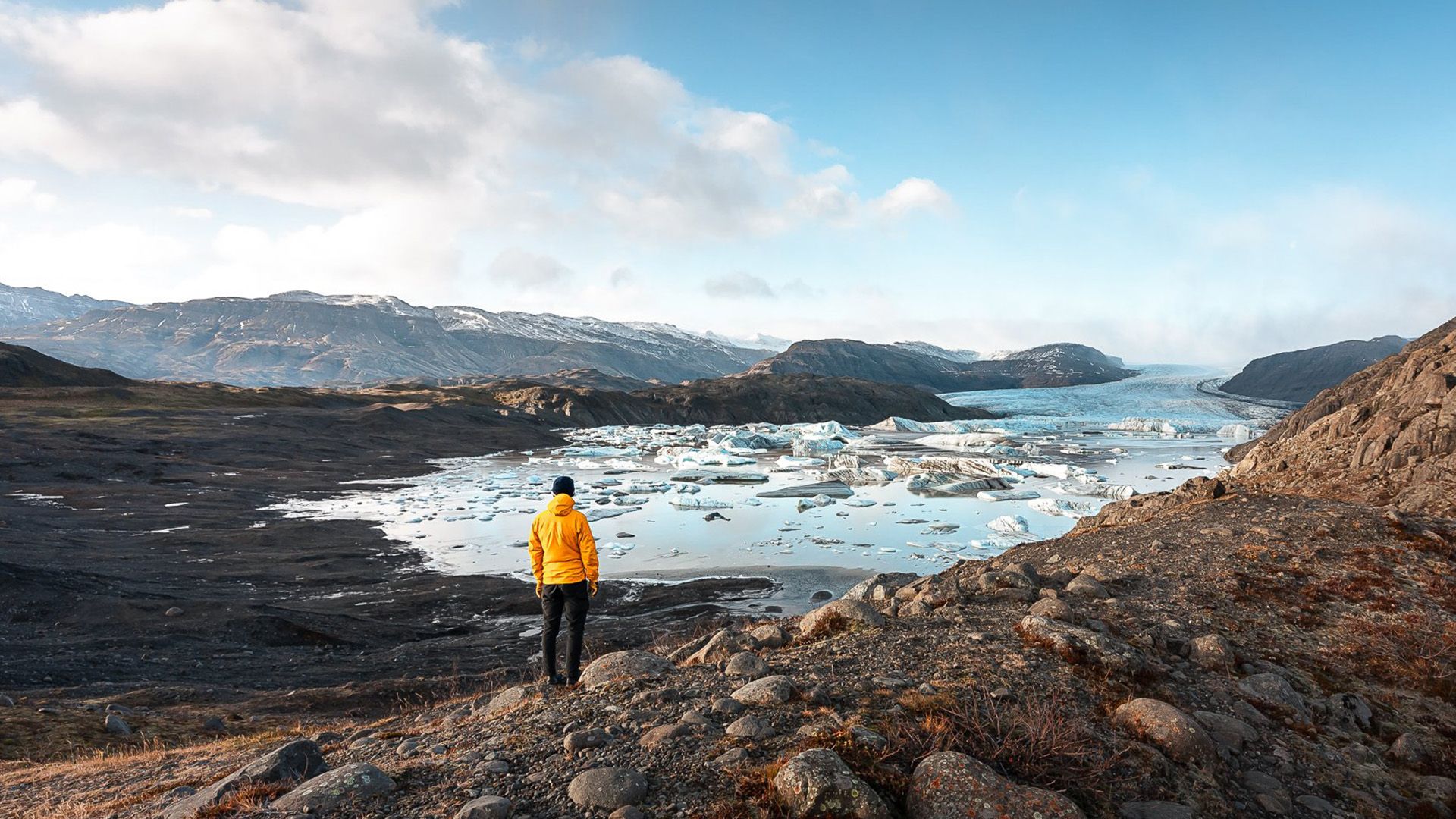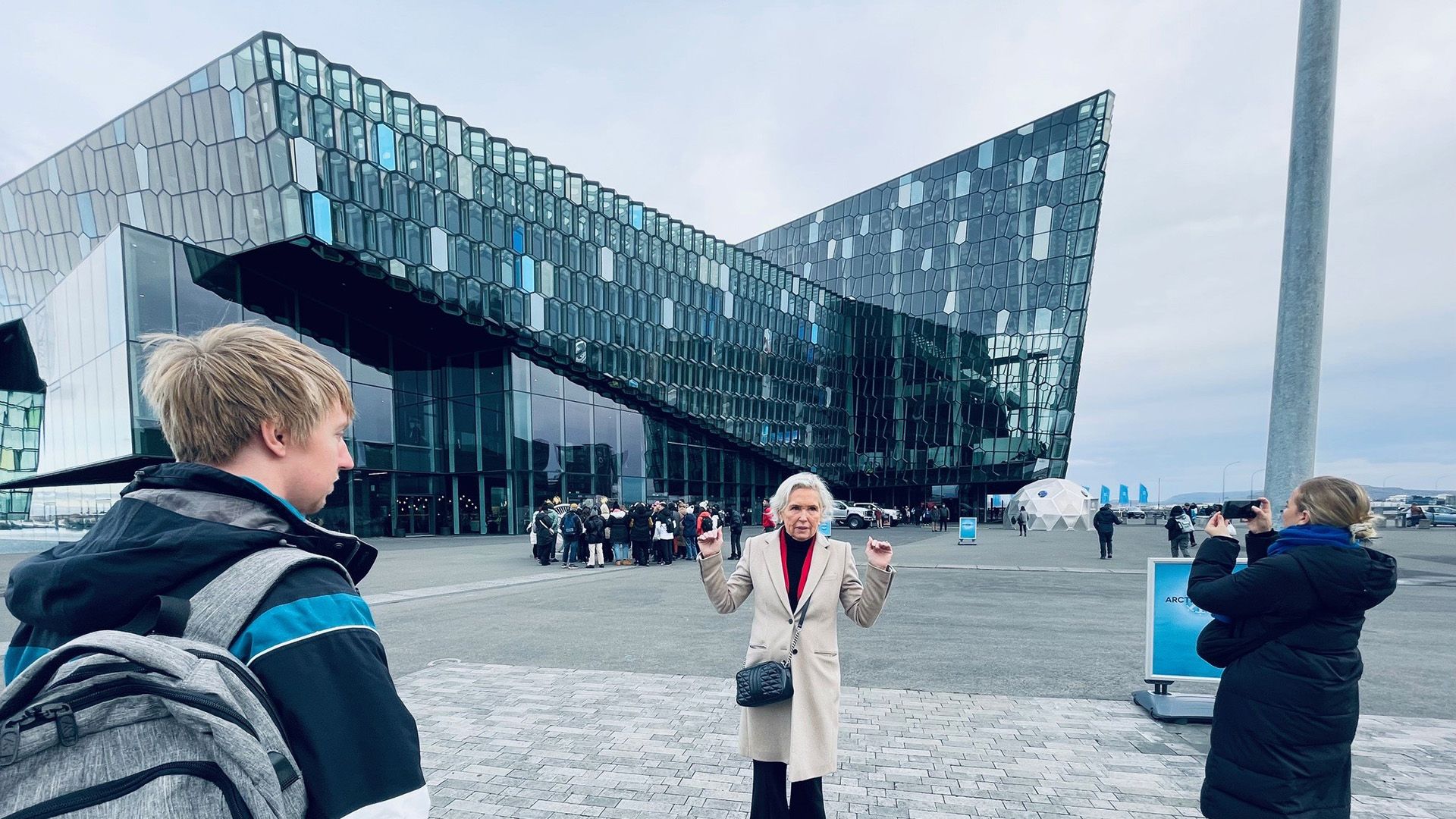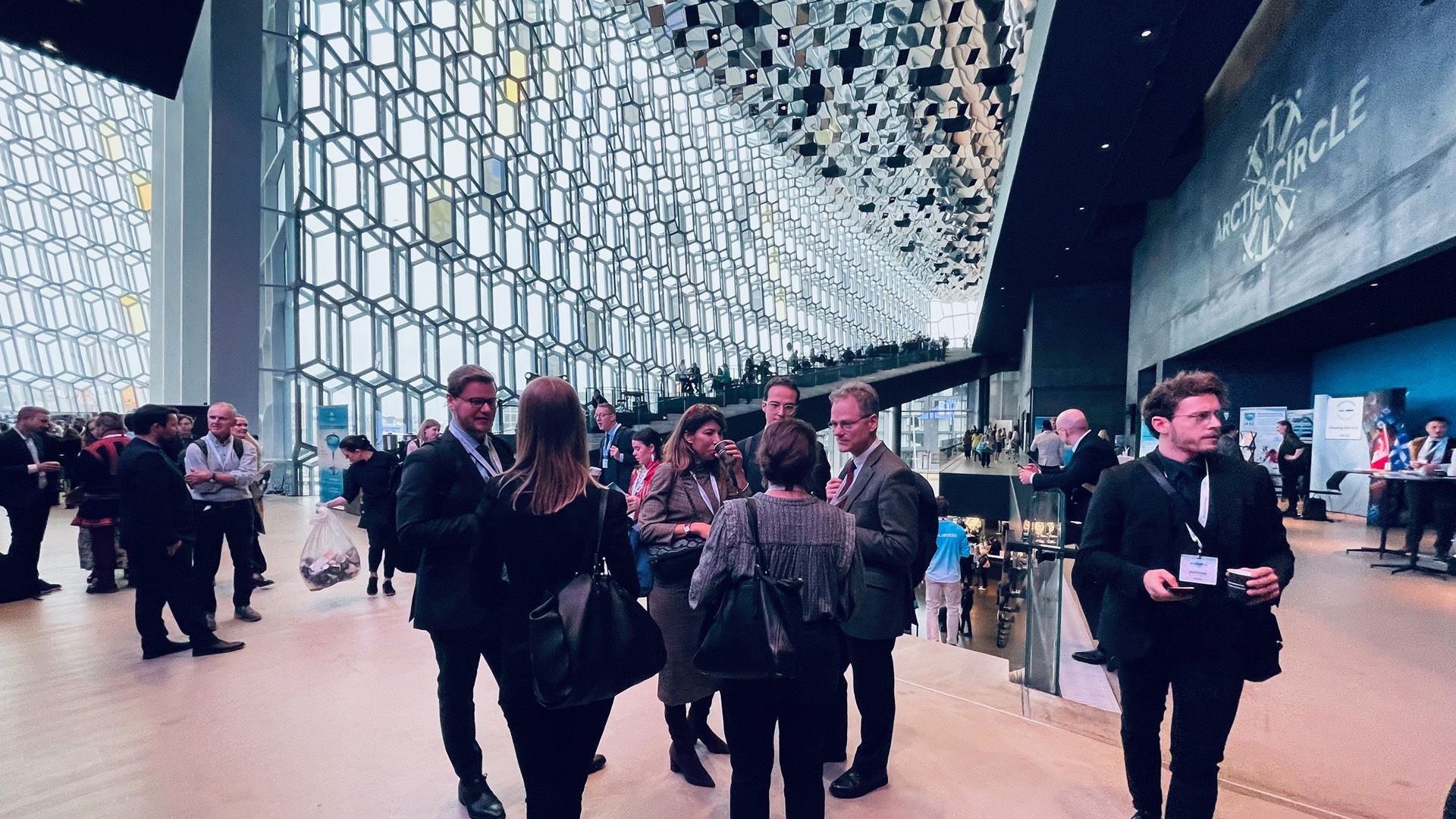
Iceland
Heralds of the Arctic
The Volcanic Way Eldfjallaleiðin leads to the volcanoes Fagradalsfjall, Hengill, Hekla, Eyjafjallajökull, Eldfell, Katla, Lakagígar and Öræfajökull. Visitors explore geological wonders and gain an awareness of the environment. Photo: Thráinn Kolbeinsson
The Volcanic Way Eldfjallaleiðin leads to the volcanoes Fagradalsfjall, Hengill, Hekla, Eyjafjallajökull, Eldfell, Katla, Lakagígar and Öræfajökull. Visitors explore geological wonders and gain an awareness of the environment. Photo: Thráinn Kolbeinsson
Volcanoes and glaciers, waterfalls and hot springs ... In Iceland, you can experience nature and global warming, because the glaciers are melting. This makes the Arctic a control centre in the fight against climate change. This is what the Arctic Circle Assembly in Reykjavik is all about.
Helmet, safety harness, mountain boots with crampons, pickaxe and rain gear, a trained mountain guide and a detailed introduction - this is the only way groups are allowed on Vatnajökull. After all, the glacier's ice cap is up to 1,000 metres thick and slippery, and the weather can suddenly change and become "typically Icelandic" - stormy and wet. The climate is oceanically cool, with daytime temperatures between 0 and 3 degrees in winter and between 12 and 15 degrees in summer. Welcome south of the Arctic Circle!
"Preparation is everything," Sandra Yr Dungal responds in a friendly manner to the questioning looks from townspeople as she puts on her safety harness. For the director of Iceland's largest DMC and PCO Sena, safety comes first - with adventure close behind. Their agency enables experiences in nature far off the beaten track, such as in Skaftafell National Park, 319 kilometres east of Reykjavík. The journey through the lava landscapes takes around four hours and a little longer if you take the "Path of 1,000 Waters" on the other side of the road.
Vatnajökull is the largest of the 13 glaciers in Iceland, which offer visitors unforgettable views and life lessons: Global warming is evident from the glacier extinction. Since the end of the 19th century, glaciers have receded by almost 2,200 square kilometres; since 2000 by as much as 800 square kilometres. This could cause sea levels to rise and volcanoes to erupt more frequently. Iceland has 300 active volcanoes and five eruptions in the last twelve months. The almost 400,000 Icelanders live with this, even if they have to re-route their roads here and there. They rely on plan B and constant monitoring of the volcanoes. "It's absolutely manageable," assures Kristján Bjarki Jónasson, project manager at Visit Reykjavík.
It is also a volcano that puts Iceland on the world map for travellers: in 2010, Eyjafjallajökull paralysed air traffic over Europe and drew attention to Iceland. Although 100,000 flights were cancelled, tourism has been on the rise ever since, with 2.2 million tourists in 2023. "Tourism saved our economy after the financial crisis in 2007," recalls Kristján Bjarki Jónasson. Today, the tourism industry accounts for 35 per cent of the gross national product. Arctic tours to the volcanoes, glaciers and - with a bit of luck - the Northern Lights are popular.
Arctic early warning system
The Arctic is the region of the earth around the North Pole. Changes to the environmental conditions here have both local and global consequences. This makes the Arctic the control centre in the fight against climate change. This is what the Arctic Circle, the largest network of international dialogue and cooperation on the future of the Arctic and the planet, is all about. The Arctic Circle Assembly is the largest international gathering on the Arctic. The programme includes 700 speakers. This year, 2,500 delegates from 60 countries travelled to Reykjavik, the world's northernmost capital. From 17 to 19 October, they met for the Assembly at the Harpa Concert Hall and Conference Center, the Business Forum at the Reykjavik Edition and the Polar Dialogue at the Icelandic Ministry of Foreign Affairs.
Arctic Circle Assembly 2024
Session “Forging Joint Climate Action: Accelerating Global Energy Transition” with speakers: H.E. Liu Zhenmin, Special Envoy for Climate Change, the People's Republic of China, H.E. Ólafur Ragnar Grímsson, Chairman Arctic Circle; President of Iceland 1996-2016, Oran Young, Distinguished Professor Emeritus, University of California Santa Barbara, USA Sanna Kopra, Research Professor, Arctic Centre – University of Lapland, Finland, Yang Jian, Vice President & Senior Research Fellow, Shanghai Institutes for International Studies (SIIS), China, H.E. Adnan Amin, CEO of COP 28; Director General Emeritus, IRENA.
The Arctic Circle Berlin Forum, held for the first time in May, prompted Ólafur Ragnar Grímsson, Chairman of the Arctic Circle, to send a clear message in his introduction to the panel Forging Joint Climate Action: Accelerating Global Energy Transition. "If we want to protect the Arctic, the ice and the glaciers, we have to stop climate change. And we can only achieve this through a global energy transition." Ólafur Ragnar Grímsson knows what he is talking about. The former President of Iceland (1996 - 2016) has campaigned for climate and sustainability and founded the Arctic Circle in 2013. "What we see here in the Arctic is what the world will see 20 years later. That's why the Arctic Circle is so important," emphasises Sigurjóna Sverrisdóttir. For the Account Manager at the Iceland Convention Meet in Reykjavík, this is a "wake-up call". Nature and sustainability go hand in hand in her country, but Icelanders don't talk much about it, she criticises. "We are good at telling stories about our legends and elves, but not about our environmental protection." Yet Icelanders have a lot to tell. The abundance of water and the activity of the volcanoes open up many opportunities for them. They generate all of their electricity from renewable sources; 70 per cent from hydropower and 30 per cent from geothermal energy. This can be experienced in the interactive nature museum Perlan. Under its glass dome is a huge hot water storage tank. The tanks supply the city with hot water and largely replace the winter road maintenance service, as they heat the streets and pavements.
“We love challenges”
Sigurjóna Sverrisdóttir, Account Manager at the Iceland Convention Meet in Reykjavík. In the interview she talks about Harpa, Iceland‘s landmark for MICE, the Arctic Circle Assembly, a funeral for a glacier, geothermal energy and resourcefulness.
Photo: tw tagungswirtschaft
Harpa, Hope for the future
The Harpa Concert Hall and Conference Centre uses hydroelectric and geothermal energy sources as part of its Green Policy. Harpa has completed all five stages of the Icelandic Environment Agency's Green Steps programme and submitted its first Annual and Sustainability Report last year. "Sustainability was already taken into account during the planning phase," reports Sigurjóna Sverrisdóttir. However, the investor had to file for bankruptcy during the financial crisis. Construction was halted. After discussions about the pros and cons of the project, the state and city took over the building, which opened in 2011. "We built it for hope. Hope for the future," emphasises Sverrisdóttir. When she talks about hope, she talks about values. Icelanders are rightly proud of the fact that they had the first female president in the world: Vigdís Finnbogadóttir from 1980 to 1996. Icelanders are closer to gender parity than any other country. In the World Economic Forum's Global Gender Gap Report 2024, Iceland once again comes in first place and has led the index for more than a decade. And when Icelanders see their rights restricted, more than 100,000 women take to the streets for the Equality Strike, as they did last year. Important events such as the Reykjavík Global Forum - Women Leaders in November are held in the concert hall and conference centre Harpa, as are Iceland's symphony orchestra and opera. "Harpa is our house," emphasises Sigurjóna Sverrisdóttir. And 94 per cent of Icelanders now see it that way. They are expecting the first study on the economic effects of Harpa in mid-December. Its 28,000 square metres have space for a concert hall with 1,600 seats and other halls and rooms for conferences such as the Council of Europe or the European Leadership Summit. The architecture by Henning Larsen Architects and Batteríið and the glass façades by Ólafur Elíasson draw the eye outwards and put Reykjavik at the feet of the participants.



With its glass façade, the Harpa concert hall and conference centre echoes the geometry of crystals in Icelandic bicolour spar. 2,500 delegates have travelled to the Arctic Circle Assembly. Waste separation is omnipresent in Reykjavik's venues. Photos: tw conference management
Hotels with a fireplace
It is a 15-minute walk to a dozen hotels and just a few steps to the Reykjavik Edition. The hotel from Marriott's lifestyle and luxury brand was opened in November 2021 and complements the Harpa Conference Centre. With its 502 square metres for events such as the Arctic Circle Business Forum and 253 rooms as accommodation. The lobby's fireplace with seating area, bar and stacked lava stones provide a local flavour. The Iceland Collection includes seven hotels that Icelandair sold to the Malaysian chain Berjaya Hotels & Resorts during the pandemic. The Iceland Parliament Hotel, Curio Collection by Hilton, consisting of seven reconstructed and new buildings, offers 163 rooms and six conference rooms. Special features include the Hall of Independence with 362 square metres, where Iceland signed its independence from Denmark in 1918, and the Ladies' School with 111 square metres in the former telecommunications building. For the Berjaya Reykjavik Marina Hotel, the former paint factory in the old harbour district has been converted into an urban-style hotel with meeting facilities. The Islandshotels are represented with 17 hotels. All of them carry the Nordic Swan Ecolabel and six of them offer conference facilities. The largest conference hotel is the Hotel Reykjavik Grand with 314 rooms and eleven meeting rooms for 26 to 298 people. It will be expanded by 139 rooms and ten conference rooms by summer 2027 and will then have 2,267 square metres of meeting space. The Hotel Reykjavik Saga with 130 rooms only opened in 2022.
Reykjavik Food & Wine Tour
If you want to discover Reykjavik's magic and its people, brave the weather and set off on foot on a Reykjavik Food & Wine Tour with Magical Iceland. Residents of the city such as actor Ársæll show their guests their city. The tour begins in the garden behind the parliament with an endurance test: a piece of fermented shark and a schnapps. In the perfumery Fischer Sund, guests test perfumes, accompanied by a glass of liqueur and poetry. Then it's off for a drink in the bar Uppi, for a meal in the Food Cellar Matarkjallarinn and for dessert in the Club Kjarval.
Out of Reykjavik
After a good three hours, visitors from Germany land at Leifur Eiríksson Airport near Keflavík, around 60 kilometres west of Reykjavík. Icelandair flies directly to Reykjavík from Berlin, Frankfurt am Main, Hamburg and Munich. The Blue Lagoon Iceland is located halfway to the city. National Geographic has named the Blue Lagoon one of the 25 Wonders of the World. Its geothermal seawater is rich in silica, algae and minerals that are said to heal and nourish the skin. The Blue Lagoon Retreat, which opened in 2018, is based on this concept. It offers two meeting rooms and two restaurants with views of the lagoon and lava landscape as well as 60 suites with a concierge service and a private lagoon. "We are used to groups," says Styrmir Sigurðsson, Sales and Service Manager at Blue Lagoon Iceland. He welcomes 900,000 guests a year, including 60,000 participants in meetings and incentives. In October, his guests include participants in the Arctic Circle Assembly. "With its combination of natural beauty and upscale amenities, the Blue Lagoon Retreat offers an ideal environment for productive and relaxing corporate days," advertises DMC Sandra Yr Dungal. She adds: "In addition to relaxation, corporate teams can take part in team-building activities, such as hiking on the picturesque Reykjanes Peninsula, exploring the geology of the Blue Lagoon or participating in mindfulness wellness workshops."
The Blue Lagoon is being expanded. By summer 2025, 800 guests will be able to pamper their skin and body while bathing here. Groups can explore the geology of the Blue Lagoon or take part in wellness workshops on the topic of mindfulness. Photo: tw conference industry
Anyone in Iceland who asks: "What should I not miss?" gets the answer: Get out of Reykjavik! It's the keyword for Sandra YR Dungal. "Welcome to Mars!" is how she likes to greet her guests as she drives through lava landscapes. "We at Sena have made it our mission to create unforgettable experiences for event participants in Iceland," she says, describing her concept. Her team works closely with event planners to understand their goals and the interests of the participants. Sandra YR Dungal: "By customising activities and itineraries, we ensure that each event resonates personally with the participants." To do this, she incorporates the local culture and nature. Her closeness to nature and her love of discovery allow her to seek out sustainable places such as the family-run Farm Skalakot, a boutique hotel with 14 rooms, 350 sheep and 150 Icelandic horses in the south. You can also enjoy lunch in a local farmer's goat pen with fresh dishes from the farm, garnished with lessons on sustainable goat farming. If you want to extend the experience, spend the night under the stars in a luxury tent in Thorsmörk, a remote area in the southern highlands. The "Golden Circle" can be explored in a specially converted super jeep with 44-inch tyres, the Langjökull glacier on a snowmobile tour, glacier buffet and a rave in the snowmobile bunker are included. "For an extra thrill, you can board a helicopter and take a scenic flight from the glacier for a breathtaking view of Iceland's majestic landscapes," says Sandra YR Dungal. For dinner, head to the Friðheimar Wine Bar, a greenhouse with Icelandic specialities.
Make climate change tangible for groups
To make climate change and solutions like hydropower and geothermal energy tangible for groups, Sandra YR Dungal, Director of DMC and PCO Sena, suggests: Field Visits: Organize tours of glaciers, geothermal plants, and hydropower facilities to illustrate the impact of climate change and the functioning of renewable energy.
Interactive Workshops: Host workshops where participants can build models of hydropower or geothermal systems, enhancing their understanding of these technologies.
Experiential Learning: Engage participants in outdoor activities like glacier hikes or geothermal explorations to foster a personal connection to the environment.
Expert Talks: Invite scientists and environmentalists for discussions that allow participants to ask questions and deepen their understanding of climate issues.
Community Projects: Involve individuals in local sustainability initiatives to demonstrate the importance of climate action.
Simulations: Use interactive games or simulations to illustrate climate change effects and the benefits of renewable energy in a relatable way.
Photo: Nick Caro
To bring climate change and solutions through hydropower and geothermal energy to life, she recommends the Hellisheiði power plant as a location near Reykjavik. It is one of Iceland's largest geothermal power plants, which uses modern technologies and processes to generate clean, renewable energy for electricity and hot water. "We organise many events at Hellisheiði power plant, including conferences and lectures, get-togethers and gala events." Guests can learn all about renewable energy and the operation of the power plant in the interactive museum. Sandra YR Dungal is convinced: "These activities can help participants understand the relevance of climate change and inspire them to support renewable energy solutions."